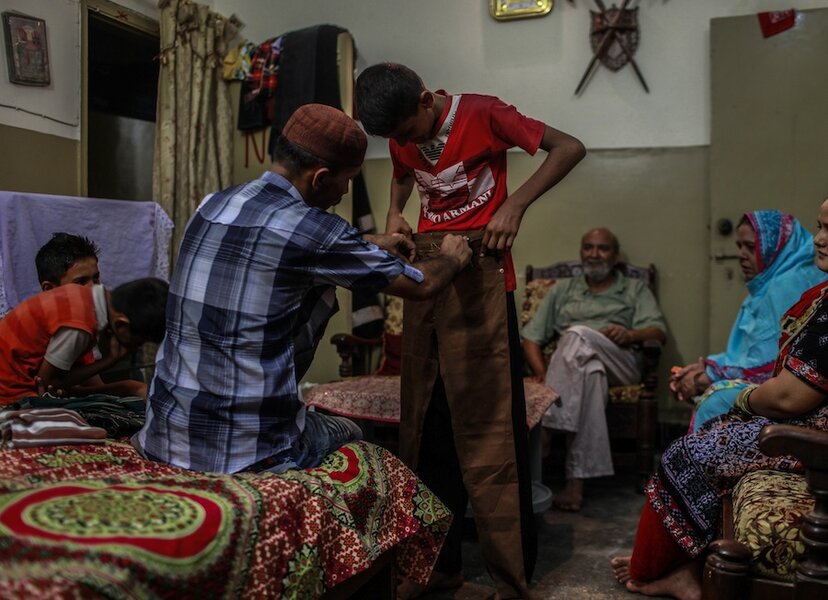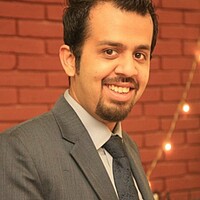For Pakistani minority sect, a tentative Eid celebration
Loading...
| Karachi, Pakistan
A handwritten sign hangs on Naeem Sohail's door, wishing passersby Eid Mubarak, a happy end to Ramadan. Underneath, there is a modest notice that henna services are available here.
No one has taken up Mr. Sohail’s daughter on her offer to apply the traditional decorative patterns on the hands of women celebrating Eid. The family wonders if it’s because they are Ahmadis, a minority sect that considers itself Muslim, but that the Pakistani state says is heretical.
Celebrations among Ahmadis – typically quieter than the traditional boisterous visits between Muslim family and friends across town – are even more muted this year. On Sunday, three Admadis, an infant, her young sister, and their grandmother, were killed after a mob attacked and burned their homes in retaliation for a Facebook post by an Ahmadi teen they considered blasphemous.
“We do not go out. Already a few neighbors have asked us if we are [Ahmadis]. So... for Eid, my children, three sons who live with me and the other one, including two daughters who live in the city will probably wish Eid over telephone,” Sohail says, remembering old times when the whole family would meet at their ancestral home.
String of attacks
Sunday's attack began after news spread of that an Ahmadi teen had reportedly posted on his Facebook account a picture of a semi-nude woman atop a holy monument in Mecca. Enraged crowds began protesting, and eventually attacked and damaged homes belonging to members of the Ahmadi community in Gujranwala City, in Punjab Province. The police stood by and watched, according to journalists' eyewitness accounts.
Afterward, all the Ahmadi families left the neighborhood. Reports suggest the teen's Facebook page may have been broken into, and that he might have not been responsible for the picture.
In May an American-born Ahmadi doctor was also shot dead in Rabwah, a city in Punjab considered the headquarters of the Ahmadi community. The doctor had come for a humanitarian trip and had only been in the country for few weeks before he was killed.
Sohail's family has been targeted, too: Last October Sohail Shah’s adult son Hafeez was shot on his way to work in Karachi by gunmen targeting members of his faith. He survived and his whole family moved out of the neighborhood they’d lived in for decades, seeking anonymity elsewhere in sprawling Karachi.
Why are Ahmadis targeted?
The Ahmadi movement started in India before coming to Pakistan. Its adherents consider their leader a prophet chosen to spread the laws of the Prophet Muhammad, a contradiction to mainstream Islam’s tenet that Muhammad is the final prophet. There are between 2 and 5 million Ahmadis in Pakistan, according to Minority Rights Group International in London.
In 1974, Pakistan Prime Minister Zulfikar Ali Bhutto, under pressure from Islamist parties, introduced a constitutional amendment that designated Ahmadis as non-Muslims. Ahmadis are also banned under Pakistani law from calling their worship houses mosques and from proselytizing.
In the three decades since the laws were introduced, 237 members of Ahmadi community have been brutally killed, but the police have convicted no one, according to statistics provided by the Ahmadi community.
In recent years, attacks against Ahmadis have increasingly been tied to accusations of blasphemy. The US Commission on International Religious Freedom says Ahmadis are the second-most targeted group under Pakistan's blasphemy laws, after Shiite Muslims.
Blasphemy accusations in Pakistan rose from one in 2011 to at least 68 last year, according to the Human Rights Commission of Pakistan. About 100 people have been accused of blasphemy this year.
There is some cheer – and dismay
Despite the gloom, Hafeez Sohail’s children seem happy because of all the shopping their mother has just brought to this temporary home. Their father is less optimistic.
“Things are not getting better for us. The hatred is increasing and the state watches it happen silently. If we had the means to leave the country, we would have. I don’t want my children growing up here with these threats,” the younger Sohail adds, as his son shows him a new pair of jeans he plans to wear the first day of Eid, which Pakistanis are celebrating today.
The names of the Ahmadi family in this report have been changed.








